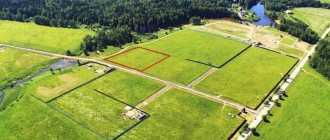The concept of land consolidation
When two (or more) adjacent land plots are combined into one, a new plot appears in the official state cadastre, and the combined adjacent ones cease to exist as real estate. Title to the new lot is given to the owner of the original lots, and if the original lots were owned by different people, then those people will have the new combined lot in common ownership.
It is necessary to take into account that according to the Land Code of the Russian Federation, the merger of land plots granted ownership on an indefinite right of use, lifelong inherited possession or by the right of free use to different persons is not allowed, but if all these plots are owned by one person, then he may well combine them according to to your will.
Conditions for combining land plots
The legislation specifically stipulates the requirements for initial sites, in particular:
- in addition to their contiguity, boundaries should be established in accordance with government regulations;
- In these territories, characteristic points must be fixed with due accuracy. If it turns out that the accuracy is lower than required by the standards, it will be necessary to further clarify the boundary points of such a section;
- The merged plots must belong to the same land category. In some cases, when the owner of a new plot will choose the type of its use, this rule may be violated;
- the initial sites must be geographically located in the same locality (municipal entity);
- if it is planned to unite land plots that are provided for indefinite use, inherited for lifelong ownership or are in urgent free use, they must have one legal holder;
- when merging plots, the permissibility of using the real estate located on them must be maintained;
- the formation of new plots should not cause disadvantages in the area that impede the protection of lands and their rational use: wedging and interspersing, brokenness and striping, and also violate the requirements,
- established in the Land Code of Russia and federal legislation.
In addition, the legislation separately stipulates the requirements for the maximum limit of land size, which must be observed for new territories.
Algorithm for combining land holdings
The first step towards achieving the intended goal will be to carry out boundary work on the territory or territories, if such operations have not been carried out previously. Land surveying can only be performed by a licensed specialist from a company that has membership in a specialized SRO. Land surveying cannot be carried out without organizing a series of geodetic surveys on the ground, so the contractor’s visit to the site is inevitable. It is unacceptable to carry out such measurements on your own, since the specialist operates with modern satellite equipment. In addition, data provided by a non-licensed professional will not have minimal legal effect.
Conducted geodetic surveys allow the engineer to collect information to establish characteristic points of land ownership and determine the exact boundaries of the territory. The result of his professional activities will be the preparation of a boundary plan for the unification of lands. This document is prepared taking into account the requirements fixed by legislators that are relevant at the time of organizing the events.
Consolidation of adjacent landholdings implies:
- Formation of a boundary plan for a new real estate property;
- Carrying out the necessary cadastral activities on the ground;
- Registration of the united territory with the State Property Committee.
Legislative acts provide for certain features applicable to the areas being merged:
- The data regarding the new site entered into the GKN database is of a temporary nature.
- The encumbrances that existed for the plots participating in the merger remain in force in relation to the new object.
- The territory being formed must be assigned an address. If it does not yet exist, information about the exact location of the land is reflected in the GKN database.
For applicants, the issue of assigning a postal address to a new site remains relevant. It is most convenient to solve the problem after all cadastral activities are completed, but before the territory is registered with the State Property Committee. This will significantly reduce the time spent on paperwork. If during the specified time period the landowner was not involved in resolving the issue of assigning an address, then he can begin these activities later, at a convenient time.
The merger procedure is considered completed when the landowner or landowners formalize their property rights in relation to the new real estate property. This is impossible without going through the state registration of property rights procedure, during which the applicant receives documents confirming his rights to the area. As soon as state registration is completed, information regarding previous sites contained in the State Property Committee database will acquire archival status.
The union is available only for territories with clearly defined boundaries and characteristic points. The procedure is the responsibility of a licensed cadastral engineer. The result of his professional activities will be the preparation of an up-to-date version of the boundary plan for the real estate being created.
The owner's decision to combine land plots into one
If the owner wants to combine the land plots belonging to him into one territory, then he cannot do without the help of specialists in order to comply with all the rules specified in the regulations, but also to embody all his own ideas. Indeed, in each case, legislative nuances of such a procedure may appear.
To carry out the consolidation of land plots in any option, it will be necessary to carry out preliminary surveying, which is, in fact, a set of works, which, among other things, includes calling cadastral service workers to the site to carry out geodetic measurements using equipment using satellites and fixing the boundaries of the new plot with conventional boundary lines signs.
Based on the results of the procedure, a boundary document (plan) is drawn up that complies with the standards prescribed by law.
If the owners are different
Sometimes using a common plot is more logical and promising than several different ones. For example, if any business activity, farming, or even large residential development for personal purposes is planned.
Citizens can agree on joint activities or construction when everyone has a plot. If they are located nearby and have a common border, then their connection will be possible.
After connecting the plots, everyone will be the owner of a share corresponding to his right to the plot. For example, if one owned land of 5 acres, and the second 10, then the share of the first would be 1/3, and the second - 2/3 in the total land allotment. However, the agreement may provide for a different division procedure.
An agreement is a mandatory document that is required in this case. This is evidenced by subparagraph 1 of paragraph 8 of Article 41 of Federal Law No. 218-FZ of July 13, 2015 “On State Registration of Real Estate.”
Download the agreement on the consolidation of land plots (sample)
Cadastral registration of a consolidated plot
After carrying out cadastral work and drawing up a boundary plan, you can proceed to the legal registration of the new site in the State Property Committee. In this case, the provisions listed in the Cadastre Law (Federal Law No. 221-FZ) must be observed, namely:
- information about the newly formed territory entered into the cadastre is initially temporary;
- all existing restrictions (as well as encumbrances and easements) of the original plots (if they did not arise as a result of the signing of contracts) in relation to the new plot are preserved to the same extent;
- if the new site was not assigned an address according to the established rules, a detailed description of its location is indicated in the State Property Committee.
If we talk about obtaining an address for the land, it is more convenient to do this after the geodetic work is completed, but before the cadastral registration process begins, since it takes less time for the owner of the new territory. However, the law does not prohibit assigning an address to a new plot after its cadastral registration.
The consolidation of plots becomes legally finalized when the state registration of ownership of the new plot takes place, and the accounting authorities, having received information about its implementation, assign the status of “archive” to the previously separated plots.
Where to apply
The newly formed plot must be registered in the cadastral register and the rights to it must be registered.
The Moscow region includes several institutions where you can register a new land plot:
- Rosreestr;
- MFC;
- Online portal of public services.
Regardless of the chosen method of submitting documents for registration of property, the applicant must have the following papers in his hands:
- Documents certifying the fact of land ownership;
- Lease deed and landlord’s consent to carry out the merger process;
- Plan for the design of plot boundaries;
- Documents confirming the identity of the owners of the plots;
- An application in which a request is made to put the land on the site and register the rights to it (you can find a form to fill out on the Internet or at the Rosreestr service branch);
- Bank statement indicating payment of state duty.
All listed documents must be provided to the Rosreestr employee exclusively in the form of originals. Photocopies are not accepted.
The procedure for combining land plots and documents for its registration
To unite land plots, each of them must be officially registered in the State Property Committee, as well as in the register of ownership of real estate. Registration must be supported by appropriate documentation. The merged areas must have the same purpose and common features.
List of required documents:
- Documents on ownership (state act on the right of ownership (use), lease agreement, certificate) and the presence of a cadastral number.
- Documents confirming the emergence of proprietary rights (purchase and sale agreement, certificate of inheritance, agreement on gift, exchange or lifelong maintenance, decision of executive authorities or court, as well as local council, administration order, etc.).
- Personal documents of the owner (user) of the plot: for citizens - a copy of the passport (first and second page and registration) and TIN code; for legal entities - a registration certificate, a copy of the Charter and a tax payer certificate and a certificate from the USREOU.
- If the site is developed, then documents confirming that the buildings have registered owners.
- For non-agricultural lands - a certificate of address confirmation.
If the plot is located within the boundaries of a garden plot, then documents from its managers will be required (certificate with the plot number, certificate of the garden society, certificate confirming registration, copies of the Charter, tax payer certificates, certificate of the garden society from the Unified State Register of Enterprises and Organizations).
The procedure for merging areas will be as follows:
- writing a statement of consent with the association from a notary, signing an agreement with land managers;
- preparation of documentation and its approval;
- obtaining an extract from the State Property Committee and a certificate of ownership.
Cancellation of land consolidation
According to the Federal Law on Cadastre (No. 221-FZ), deleting information about a consolidated land plot from the State Property Committee is possible, since when a new plot is registered in the cadastre, according to the law, temporary information is entered, which is such until the rights to the formed the object will be registered officially or after five years from the date of registration of the object.
After this, deregistration of the plot is possible only when it is converted real estate and, in accordance with the law, the decision on its formation can be canceled.
Procedure
The connection should begin with verbal agreement on the terms of the subsequent procedure, because if you do not agree immediately, then in the future the process will be slowed down or completely interrupted. In the future you will need to perform the following steps :
- contact a cadastral engineer. It will be necessary to designate common points, that is, the boundaries of the plots;
- agree on the boundaries of the new site. Also carried out by a cadastral engineer;
- coordinate new boundaries with the owners of nearby plots. If someone refuses to consent, the matter may be taken to court for review;
- prepare a boundary plan;
- conclude an agreement;
- submit documents to Rosreestr.
After this, you need to wait for the issue to be considered and receive an extract from the Unified State Register.
It is possible that the plots being merged have not been registered with the cadastral register. This does not deprive the owners of the right to unite; simply, accounting will be carried out for the newly created object.
The basis document that will be used for the purpose of cadastral registration and unification is the boundary plan. Without it, the procedure will be completely impossible.
Cost of merging plots
No specialist will be able to tell you exactly how much the procedure for connecting land plots might cost unless he has information about your specific plots and the situation with documents and other information about what needs to be done. There are several criteria for assessing the cost of cadastral services, such as:
- complexity of the work ahead;
- area of objects;
- Accessibility by road;
- additional costs for the provision of related services;
- the presence or absence of any documents.
After a cadastral service specialist has visited the site, he will be able to assess in more detail the scope of the upcoming work and tell you the exact (or estimated) price that you will need to pay for preparing your plots for cadastral registration.
Author of the article
Price
The cost of the procedure for merging plots depends on the characteristics of the plots, the form of management, and other factors. Only when considering a specific situation will specialists be able to make preliminary cost calculations . There are several main factors that determine the price.
- Area of plots.
- The complexity of the work that will be associated with the merger.
- The presence or absence of documents for the entire transaction.
- Additional expenses.
A cadastral specialist will be able to accurately estimate the cost of upcoming work. To reduce costs, you should put in order all the documents that will be needed for the procedure in advance.









